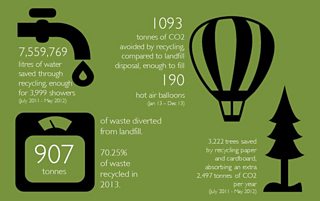Broadcasting House is one of the world’s largest broadcast complexes situated in the heart of the capital. It houses nearly 6,000 staff, and provides public service broadcasting via three 24-hour television news channels, nine radio networks and 27 international language radio services to a worldwide audience of 265 million people every week. Key to the design was that the building should deliver the best environmental performance possible. No small challenge then for a building broadcasting 24/7.
But we have risen to the challenge and, last month our efforts were rewarded when the building achieved an Excellent rating from BREEAM, the industry code for assessing a building’s sustainable environment.
So how have we achieved this? From the outset, the building was designed to a 'Excellent' standard, with several examples of good practice supporting that.
- The recycling facilities in office hubs were designed to encourage more sustainable behaviours, being easy to use with clear simple signage for the two waste streams of mixed recycling and general waste and located in areas convenient for staff. This is supported by two compactor units in the loading bay which efficiently store recyclables and waste in a space-limited area.
- Low-flush toilets and water-efficient aerating taps help reduce water consumption and AMR water meters are being installed to further improve management of water.
- An automatic lighting control system with limited light switches and the use of PIR occupancy sensors ensure lights switch off in many areas when not needed; and perimeter lights near the windows have automatic dimming controls which relate to the amount of daylight.
- Cycle storage facilities are provided for 600 bicycles, with associated showering/changing facilities to encourage and enable sustainable transport by staff.

The facts at a glance
- 70.25% of waste recycled in 2013 (Jan 13 – Dec 13), with 907 tonnes of waste diverted from landfill.
- 1,093 tonnes of CO2 avoided by recycling, compared to landfill disposal, enough to fill 190 hot air balloons (Jan 13 – Dec 13).
- 7,559,769 litres of water saved through recycling, enough for 3,999 showers (July 2011 - May 2012).
- 3,222 trees saved by recycling paper and cardboard, absorbing an extra 2,497 tonnes of CO2 per year (July 2011 - May 2012).
- Motion sensors throughout the building that switch off lights to save energy and monitor temperature.
- Solar sensitive glass façade.
- A heat reclamation system that allows fresh air to be recycled.
- High levels of natural daylight throughout the building.
- Technology procurement is rated as EPEAT®GOLD (the industry standard for green electronics).
- All timber used in the building has been FSC sourced.
- Recycling points are situated in every hub in the building.
- There is cycle parking for 600 bikes.
- State of the art low energy production lighting in the majority of our TV studios.
- Where possible, UK-based designers and suppliers have been used to fit out Broadcasting House, focusing on new talent and taking designs that are environmentally friendly, durable and cost effective.
- The PVC flooring in Radio 1 and the News Café is made up of raw materials from renewable or inexhaustible resources.
- All the glass splash backs and surfaces in the hubs are made from recycled glass.The fabrics used throughout the building, for example in the seating, are 78% sourced from the UK.
All in all, the move into Broadcasting House from the ��������’s old base at Television Centre has contributed to making the estate as a whole more sustainable and helped the �������� reach its goal of reducing energy consumption across the estate by 20%, and associated CO2 emissions.
Andy Baker is W1 Manager
